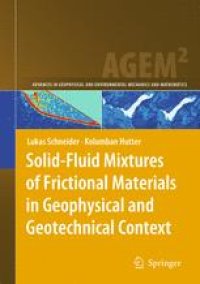
Ebook: Solid-Fluid Mixtures of Frictional Materials in Geophysical and Geotechnical Context: Based on a Concise Thermodynamic Analysis
- Tags: Geophysics/Geodesy, Classical Continuum Physics, Mathematical Applications in Earth Sciences
- Series: Advances in Geophysical and Environmental Mechanics and Mathematics
- Year: 2009
- Publisher: Springer-Verlag Berlin Heidelberg
- Edition: 1
- Language: English
- pdf
Mixture concepts are nowadays used in a great number of subjects of the - ological, chemical, engineering, natural and physical sciences (to name these alphabetically) and the theory of mixtures has attained in all these dis- plines a high level of expertise and specialisation. The digression in their development has on occasion led to di?erences in the denotation of special formulations as ‘multi-phase systems’ or ‘non-classical mixtures’, ‘structured mixtures’, etc. , and their representatives or defenders often emphasise the di?erences of these rather than their common properties. Thismonographisanattempttoviewtheoreticalformulationsofprocesses which take place as interactions among various substances that are spatially intermixedandcanbeviewedtocontinuously?llthespacewhichtheyoccupy as mixtures. Moreover, we shall assume that the processes can be regarded to becharacterisedbyvariableswhichobeyacertaindegreeofcontinuityintheir evolution, so that the relevant processes can be described mathematically by balance laws, in global or local form, eventually leading to di?erential and/or integralequations,towhichtheusualtechniquesoftheoreticalandnumerical analysis can be applied. Mixtures are generally called non-classical, if, apart from the physical laws (e. g. balances of mass, momenta, energy and entropy), also further laws are postulated,whicharelessfundamental,butmaydescribesomefeaturesofthe micro-structure on the macroscopic level. In a mixture of ?uids and solids – thesearesometimescalledparticleladensystems–thefractionofthevolume that is occupied by each constituent is a signi?cant characterisation of the micro-structure that exerts some in?uence on the macro-level at which the equations governing the processes are formulated. For solid-?uid mixtures at high solids fraction where particle contact is essential, friction between the particles gives rise to internal stresses, which turn out to be best described by an internal symmetric tensor valued variable.
This book puts the theory for a mixture of hypoplastic constituents on a rigorous basis using the thermodynamic analysis of M?ller and Liu. The results which are specialised to frictional solid-fluid mixtures can be used by geophysicists and geotechnical engineers to refine their existing models for debris flows. This book addresses a continuum mechanical formulation of structured solid-fluid mixtures for elasto-viscous-frictional materials, suitable for particle laden and dense solid-fluid flows under small to catastrophic motions. Volume-fraction densities and balance laws for stress-like variables describe effects of the microstructure and hypoplasticity, and non-vanishing production rate densities of mass and momentum account for the description of compressibility or density preserving of the constituents, fragmentation, abrasion and particle separation. Saturation is equally incorporated. Using M?ller’s entropy principle, paired with a number of plausible ad-hoc assumptions, the theory delivers explicit expressions for the constituent stresses, interaction forces, entropy, heat and entropy flux. A reduced model for a binary mixture yields an extension of the hypolasticity to multi-phase systems and points at the restrictions of the popular stress equilibrium assumption.
This book puts the theory for a mixture of hypoplastic constituents on a rigorous basis using the thermodynamic analysis of M?ller and Liu. The results which are specialised to frictional solid-fluid mixtures can be used by geophysicists and geotechnical engineers to refine their existing models for debris flows. This book addresses a continuum mechanical formulation of structured solid-fluid mixtures for elasto-viscous-frictional materials, suitable for particle laden and dense solid-fluid flows under small to catastrophic motions. Volume-fraction densities and balance laws for stress-like variables describe effects of the microstructure and hypoplasticity, and non-vanishing production rate densities of mass and momentum account for the description of compressibility or density preserving of the constituents, fragmentation, abrasion and particle separation. Saturation is equally incorporated. Using M?ller’s entropy principle, paired with a number of plausible ad-hoc assumptions, the theory delivers explicit expressions for the constituent stresses, interaction forces, entropy, heat and entropy flux. A reduced model for a binary mixture yields an extension of the hypolasticity to multi-phase systems and points at the restrictions of the popular stress equilibrium assumption.
Content:
Front Matter....Pages i-xxiii
Introduction....Pages 1-14
Mathematical Preliminaries and Notations....Pages 15-27
Introduction to Mixture Theory....Pages 29-53
Constitutive Assumptions....Pages 55-73
Entropy Principle and Transformation of the Entropy Inequality....Pages 75-89
Thermodynamic Analysis I Liu Identities, One-Forms and Integrability Conditions....Pages 91-122
Thermodynamic Analysis II Residual Inequality, Thermodynamic Equilibrium, Isotropic Expansion....Pages 123-152
Reduced Model....Pages 153-187
Discussions and Conclusions....Pages 189-195
Back Matter....Pages 1-50
This book puts the theory for a mixture of hypoplastic constituents on a rigorous basis using the thermodynamic analysis of M?ller and Liu. The results which are specialised to frictional solid-fluid mixtures can be used by geophysicists and geotechnical engineers to refine their existing models for debris flows. This book addresses a continuum mechanical formulation of structured solid-fluid mixtures for elasto-viscous-frictional materials, suitable for particle laden and dense solid-fluid flows under small to catastrophic motions. Volume-fraction densities and balance laws for stress-like variables describe effects of the microstructure and hypoplasticity, and non-vanishing production rate densities of mass and momentum account for the description of compressibility or density preserving of the constituents, fragmentation, abrasion and particle separation. Saturation is equally incorporated. Using M?ller’s entropy principle, paired with a number of plausible ad-hoc assumptions, the theory delivers explicit expressions for the constituent stresses, interaction forces, entropy, heat and entropy flux. A reduced model for a binary mixture yields an extension of the hypolasticity to multi-phase systems and points at the restrictions of the popular stress equilibrium assumption.
Content:
Front Matter....Pages i-xxiii
Introduction....Pages 1-14
Mathematical Preliminaries and Notations....Pages 15-27
Introduction to Mixture Theory....Pages 29-53
Constitutive Assumptions....Pages 55-73
Entropy Principle and Transformation of the Entropy Inequality....Pages 75-89
Thermodynamic Analysis I Liu Identities, One-Forms and Integrability Conditions....Pages 91-122
Thermodynamic Analysis II Residual Inequality, Thermodynamic Equilibrium, Isotropic Expansion....Pages 123-152
Reduced Model....Pages 153-187
Discussions and Conclusions....Pages 189-195
Back Matter....Pages 1-50
....